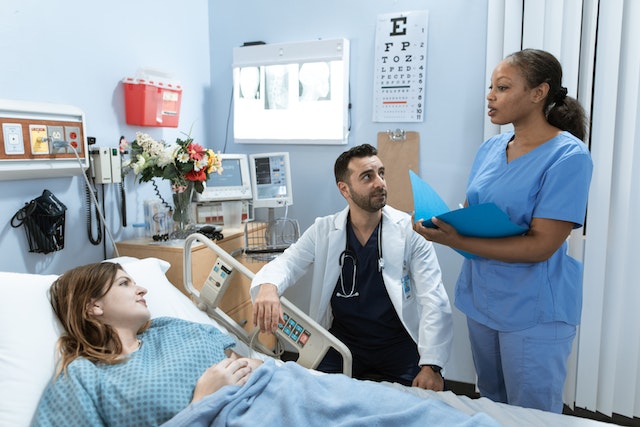
Nursing is a complex career path that provides different challenges and cases every single day. However, there’s much to learn from practice alongside intensive study – which, of course, is why placements at clinics and hospitals are so popular.
However, increasing demand for nurses and higher-quality education means that more and more institutions are leading with mock simulations for students to follow. While the word ‘simulation’ suggests virtual reality or advanced technology, it frequently refers to mock situations that don’t require real patients.
With increasing numbers of nurses learning ‘on the job’, is there still a case for simulations? Why might traditional simulation practice still help student nurses learn the skills they need to advance in healthcare? Let’s consider a few potential scenarios.
What is a nursing simulation?
Nursing simulations, as mentioned, don’t always refer to advanced technology (despite the common misconception). In fact, they frequently refer to practice situations where students can show what they’ve learned from modules and coursework on a practical stage.
For example, some simulations may provide student nurses with ‘dummies’ they can use in a resuscitation scenario or where midwives may need to deliver breech babies. While clinical placements provide student nurses with experience ‘on the job’ and allow them to put their knowledge into practice, many see simulations as safe training models before heading to real clinics.
Nursing simulations help educators and mentors assess students on their knowledge, critical thinking skills, and how they react in high-stress situations. Therefore, students or those taking part in simulations can learn from their practice and make adjustments in future simulations before moving on to real patients and cases.
Of course, the role of simulation nursing education is already important in various courses and university modules, such as those available at Walsh University. Walsh University, in fact, provides a thorough experience where students can learn, practice, build from mistakes, and continue using simulations to gain extra confidence.
Nursing simulations may seem a little outdated to some student nurses and even those who have already graduated. However, there are several reasons why using simulations is preferable to getting straight into patient care.
The benefits of nursing simulations
Nursing simulations, of course, allow students and those undergoing training to show that they understand what is written on a page. It simply isn’t practical for nurses to head straight into healthcare with purely theoretical knowledge!
Nurses must be confident and quick to act in physical locations from the get-go. While there is an ongoing shortage of nurses in the US, this does not mean that hospitals and clinics are hiring poor-quality graduates.
Here are a few reasons why and how nursing simulations are so important in modern healthcare education, and why they’re likely to endure years of training to come.
They’re safe practice scenarios
The immediate benefit of using nursing simulations is that students and trainees don’t have to worry about practicing on a real patient. It is highly beneficial for the student, any hospital involved, and, of course, the patients.
While heading to clinical placement provides nurses with worthwhile experience working in a team in a fast-paced environment, they will not always get the chance to work with patients on complex cases or in emergencies. This is frequently because of the safety protocols involved.
It is simply not safe, many healthcare bodies argue, for nurses who are yet to graduate to handle high-risk and emergency cases solo. Therefore, nursing simulations are ideal for practice – and to ensure that students build the knowledge and technique they need before heading to placements and other real-world scenarios.
Working in simulations means that nursing students learn where they might make mistakes long before they head to a clinic for real. There’s no risk of any patients coming to harm, or any hospital or clinic feeling the time crunch as a result.
They’re ideal for building confidence
Many nurses starting their education may not feel confident heading into real-world situations right away, even after months of theory study. It’s a reasonable assumption – for many students, this will be the first time they’re caring for people, period.
Simulations remove the real-life pressure but still expect students to demonstrate how they would react and manage a potentially life-threatening scenario under pressure. While there may still be some stress involved while taking on a simulation, there is at least no threat of any harm to a patient due to poor practice.
Students can take on simulations across their studies to gradually build more confidence and technique, with their teachers and educators helping along the way.
Simulations are also ideal for building confidence in tutors. Nursing educators need their students to graduate not only with the right grades and theoretical answers on paper, but also with the technique and confidence to attend to patients in real-life hospital situations.
Nursing educators need to be confident that their students will help patients with self-assurance and clear thinking. Simulations provide tutors with an ideal opportunity to spot any potential problems early on, to advise their students, and to help them adjust far ahead of graduation.
Simulations take many different forms
Years of simulation advances now mean that nursing students have access to various mock scenarios and mannequins (or dummies) to work with in practice situations. Therefore, students and trainees work with more than just one or two basic or set dummies for all their mock scenarios.
For example, low- and high-fidelity mannequins exist to help students practice real-life care with responses that mimic those of real patients (without the communication!). The higher the fidelity of a dummy, the more realistic they are. This means that some may have heartbeat sounds or react to nurses’ physical decisions.
Nurses may even be able to monitor some patient levels on hi-tech mannequins – such as blood pressure management.
The lower the mannequin fidelity, the more likely it is that they are useful in basic nursing education. Students will also find partial dummies and mannequins to focus on specific areas of the body and treatment.
Ultimately, this variety of simulators and mannequins means that there’s flexibility for nursing students to learn specific techniques close-up. To begin with, they might practice on low-fidelity models to ensure that they get basic skills down pat. Later in their courses, they might move on to higher-fidelity systems to practice more complex skills.
Practice at this depth simply isn’t possible with real patients – lives would theoretically be at risk, hospital standards would suffer, and it wouldn’t ever build confidence for students taking part.
Simulations show students how quickly scenarios change
Something that nurses learn early on in their education is that cases are rarely as simple as they seem. While there might be straightforward root causes to conditions that are quick to assess and manage, there’s just no guarantee how patients will progress during treatment.
Highly technical and advanced simulations can mimic patient progress through everyday and advanced nursing techniques. These technical dummies show students the potential for dramatic change in condition and that emergency situations can arise despite all the best preparations.
Therefore, simulations are ideal for showing student nurses that patient care is complex and that they will need to think critically and without emotion to react to sudden shifts in condition. For example, simulations may mimic sudden blood loss, loss of oxygen, or heart attacks during treatment.
It’s here, therefore, that student nurses would hypothetically look for support from other staff, locate drips and physical apparatus, and practice CPR on their patients if necessary.
The role of simulations to this extent is not to scare nursing students – rather, it’s the perfect opportunity to ensure that they have the confidence and technique to save lives in high-pressure scenarios if and when they arise.
Student learning outcomes improve
Simulations are not just useful for building confidence and helping nursing students understand what to expect from real-world cases – in fact, they help to pursue learning outcomes that are otherwise hard to measure through theory coursework marking alone.
For example, simulation outcomes will help students understand the importance of clear communication in high-pressure scenarios. They will get the opportunity to communicate with other nurses and nearby staff to ensure that patients get the care they need without putting them at risk.
It’s also a great opportunity for students to build teamwork skills and to learn how to work with others. While there will likely be some opportunities to collaborate in theoretical study, simulations help nursing students come together and understand how to react and work with each other in real-world situations.
Nurses undertaking simulations also show educators and assessors how they react to clinical decision-making. It’s not just an opportunity to learn what to do in high-pressure cases but also how to make educated decisions from patient to patient. Rather than relying on their gut, a student can demonstrate that they pull from their pool of knowledge and act at short notice.
Simulation sessions provide educators with useful data to effectively debrief students. They can find areas needing development and extra practice, for example, and draw on how students reacted during simulations. Tying these training points back to their simulation performances can help student nurses better visualize how to improve and develop.
It’s an opportunity to learn a broad range of skills
One of the key ‘pros’ of simulation learning vs placement learning is that technical simulations provide nursing students with a wider range of potential cases and problems they might come across when working in a hospital for real.
Ultimately, there’s no guarantee what cases or scenarios nurses may encounter when heading to placement. There’s simply no element of educational control. While it might be a good opportunity for nurses to learn in teams and at a fast pace, simulations provide a great deal of control over what nurses learn and to what extent.
Nurses can learn how to handle potential emergencies without them physically arising, for example. They’ll also get the chance to work with complex conditions and cases that aren’t guaranteed to emerge during placements.
This means that nursing students can expect a well-rounded experience. While they may not use all the skills and techniques learned through simulations while working in real hospitals, they will at least have the core knowledge and practice experience there to draw upon when needed.
This, of course, also helps to boost student confidence, which is vital heading toward graduation and into real-world nursing.
There’s always support to hand
In real-world nursing scenarios, there will not always be opportunities for graduates to fall back on educators and other team members for advice and support. Heading into healthcare is very much ‘hitting the ground running’ – while there will be support available, there’s simply no guarantee, given the ever-changing demands in clinical practice.
Simulations, however, provide student nurses with clinical practice opportunities in a supportive environment. Educators will encourage students to work on their own (albeit under supervision), but are on hand at the end of exercises to give support where needed.
For student nurses, this provides a highly supportive safety net should they have questions or feel less than confident about their performance. While there will only be limited time for nurses to gain confidence before graduating, simulations will at least help them get to where they need to be with efficiency.
For many nursing students, simulations are helpful in identifying potential mistakes, and how to bounce back from them. With experienced educators at hand to help during simulation exercises, students can keep practicing and debriefing to build confidence ahead of graduation.
Conclusion
There are places for simulations and clinical placements in nursing education – and, in fact, both can run alongside to ensure that students build confidence in a range of complex practices.
Simulations, however, help nurses to build confidence and learn from their potential mistakes without putting patients at risk. Beyond this, it’s a great opportunity for educators to spot problems and help coach students before they reach a real clinic.
Nursing students can expect to cover a wide variety of cases and problems via simulations – this way, they’re well-rounded and well-prepared for the fast-paced, ever-changing world of patient care.
Nancy Cole has over 15 years experience as a educator and health practitioner. She has a B.S. from Brock, and a Ph.D. in biology from the University of Guelph . Nancy has worked as a special medical consultant for a major insurance provider before becoming a freelance health author and public speaker.





